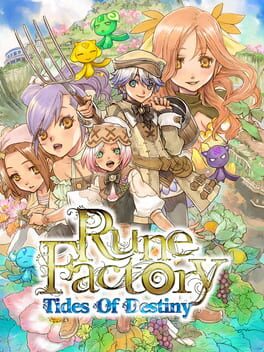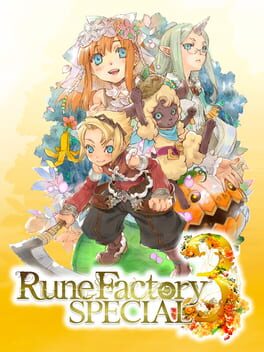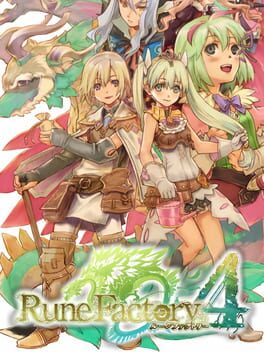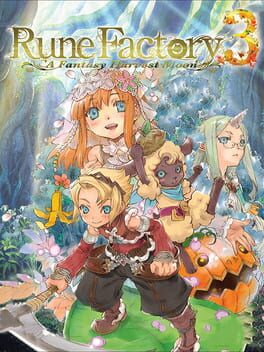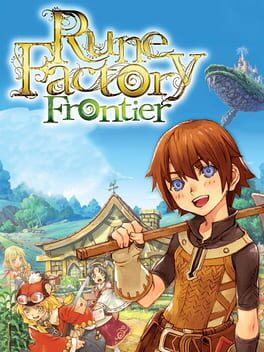

Aden and Sonja, two lifelong friends, live a tranquil life on Fenith Island until they're struck by a mysterious curse: they awaken to find both of their souls are now trapped in the same body! On top of this unusual calamity, the Fenith they knew is gone, replaced by a strange island populated with unfamiliar faces. Only by exploring this new world will they be able to solve the mystery of this curse and save their beloved Island. During the course of their journey, Aden and Sonja will be aided by a colorful cast of characters, as well as take command of the towering golem Ymir. Using their newfound giant friend, they'll cross vast seas, discover hidden islands and dungeons packed with riches, and battle fearsome monsters of the deep!
Also in series
Reviews View More
Among Rune Factory games, Tides of Destiny is likely the most polarizing. While technically not the first console, 3D entry to the series -- Frontier precedes it -- it's a game that went its own way, with an original story and characters as well as reimagined mechanics that further distanced the RF series from its parent Harvest Moon, a direction not everybody took well to. I, myself, however, found it to be an important step forward for the RF series.
The first gameplay twist is pretty obvious from "Tides" being in the name of the game. Instead of the town you live in being on a contiguous landmass with the rest of the world, it is an island amidst many others. To progress the story -- in fact, to even be able to farm -- you have to explore the seas and find the correct islands. Notice that I don't use the word "sail" here. Everything is done atop your very own giant golem, Ymir, whose feet can reach the very bottom of the ocean. Ymir can be ridden into the sea, and he lifts islands from the seafloor so you can explore them.
The golem thing is somewhat confusing at first, but it serves its purpose well, adding this unique flavor to the exploration where the place you're looking for might not be there at first. And it's clear the designers put great care into the golem riding feature, as they even made it so you can fight giant sea monsters while on Ymir. Can't really have our character ride a giant construct without a kaiju battle, can we? Such battles are simple, consisting mostly of punching and blocking, but it's an amusing thing to do.
Combat in the main game is quite simple as well, as far as 3D action games go, but it's a bit more elaborate than the top-down RFs. There's a main attack button and a jump button (effectively used for dodging), and while you can get through the entire game just by using those, as you level up your weapon skill, some special moves become available. There are six different types of weapon, each of which has different damage, speed, range and special moves to suit different playstyles.
All weapons are viable if you take the time to learn them, and skill is not as important as keeping your gear up to date. That's where the crafting system comes in: crafting makes up for most of the time spent outside of dungeons, and through it, you can make food, weapons, tools, accessories, medicine and furniture. That happens to be not only the best way to get an edge in combat, but also, it's through it that you'll make most of the money you'll ever need.
Now, you're probably thinking "In a game with such well-developed systems, farming must be incredible!" and... well, hold your horses. I did say the game distanced itself from HM, and farming was practically a casualty. It's still here, but it's been mushed with the monster taming system: the player character no longer plant seeds themselves, but instead assigns monsters to work on the field, and the crops obtained will vary depending on the type of monster and how high their friendship is.
Farming is a secondary mechanic in the game, and it exists to supply crafting ingredients and to fulfill villager requests. On the latter... this is a 2011 game, and farming sims have come a long way since then, but back then, ToDs villagers were outstanding. They had relatively elaborate schedules; their dialogue was improved with them being made aware of festivals, past conversations with you and happenings surrounding other villagers; and they'd also comment on what you're wearing and even wear accessories you gift them.
What made them really special, however, is that all villagers had friendship events for every time you leveled up their friendship. During these events, you got to know that character better, either through a series of conversations on different topics, or through a storyline that developed as the friendship level increased. Again, this is not as impressive if you're coming from more recent games, but at the time, ToD really took it to a new level. It built a sense of living in a real community, and it made preceding games NPCs look like bots in comparison.
That being said, the writing is still far from perfect, and it leans into deeply troubling territory all too often. For instance, with sexism: male characters are told to "be a man" in their events, while female ones get to hear that learning cooking and laundry is "going to be useful once you're married". The absolute worst bits, though, come during the postgame, when romance starts being a thing. Off the top of my head, there's a couple of obvious gal pals whose friendship events revolve around their relationship, but who then suddenly forget about all that and decide what they really want is a piece of Aden. In addition to that, there's the bachelor who uses straight-up pick-up artist tactics on Sonja.
Poor Sonja. Yet another innovation for RF in Tides of Destiny was the ability to play as a female character, though the way it was done, it feels like an afterthought. As the game's main story goes, you play as childhood friends Aden and Sonja, who are going about their lives in Fenith Island until, one day, they find themselves teleported to a mysterious land. If that wasn't bad enough, they also find themselves sharing one body -- that of Aden. This means that, until the main narrative is done, you're forced to play as Aden anyway. And you might as well stick with him, since Sonja gets absolutely shafted when it comes to romance options. Aden gets a whopping ten bachelorettes to choose from, while Sonja gets only four (three when you cross out the PUA), and of course there are no same-sex marriages.
Maybe it's too much to expect for a 2011 game to take the series that far. Well, it's not, but anyway. Rough edges aside, Tides of Destiny was a very positive surprise -- the track record for this series is to fall face down when they try to be ambitious (cough cough Rune Factory 2 cough), but ToD managed to deliver a pretty enjoyable experience.
The first gameplay twist is pretty obvious from "Tides" being in the name of the game. Instead of the town you live in being on a contiguous landmass with the rest of the world, it is an island amidst many others. To progress the story -- in fact, to even be able to farm -- you have to explore the seas and find the correct islands. Notice that I don't use the word "sail" here. Everything is done atop your very own giant golem, Ymir, whose feet can reach the very bottom of the ocean. Ymir can be ridden into the sea, and he lifts islands from the seafloor so you can explore them.
The golem thing is somewhat confusing at first, but it serves its purpose well, adding this unique flavor to the exploration where the place you're looking for might not be there at first. And it's clear the designers put great care into the golem riding feature, as they even made it so you can fight giant sea monsters while on Ymir. Can't really have our character ride a giant construct without a kaiju battle, can we? Such battles are simple, consisting mostly of punching and blocking, but it's an amusing thing to do.
Combat in the main game is quite simple as well, as far as 3D action games go, but it's a bit more elaborate than the top-down RFs. There's a main attack button and a jump button (effectively used for dodging), and while you can get through the entire game just by using those, as you level up your weapon skill, some special moves become available. There are six different types of weapon, each of which has different damage, speed, range and special moves to suit different playstyles.
All weapons are viable if you take the time to learn them, and skill is not as important as keeping your gear up to date. That's where the crafting system comes in: crafting makes up for most of the time spent outside of dungeons, and through it, you can make food, weapons, tools, accessories, medicine and furniture. That happens to be not only the best way to get an edge in combat, but also, it's through it that you'll make most of the money you'll ever need.
Now, you're probably thinking "In a game with such well-developed systems, farming must be incredible!" and... well, hold your horses. I did say the game distanced itself from HM, and farming was practically a casualty. It's still here, but it's been mushed with the monster taming system: the player character no longer plant seeds themselves, but instead assigns monsters to work on the field, and the crops obtained will vary depending on the type of monster and how high their friendship is.
Farming is a secondary mechanic in the game, and it exists to supply crafting ingredients and to fulfill villager requests. On the latter... this is a 2011 game, and farming sims have come a long way since then, but back then, ToDs villagers were outstanding. They had relatively elaborate schedules; their dialogue was improved with them being made aware of festivals, past conversations with you and happenings surrounding other villagers; and they'd also comment on what you're wearing and even wear accessories you gift them.
What made them really special, however, is that all villagers had friendship events for every time you leveled up their friendship. During these events, you got to know that character better, either through a series of conversations on different topics, or through a storyline that developed as the friendship level increased. Again, this is not as impressive if you're coming from more recent games, but at the time, ToD really took it to a new level. It built a sense of living in a real community, and it made preceding games NPCs look like bots in comparison.
That being said, the writing is still far from perfect, and it leans into deeply troubling territory all too often. For instance, with sexism: male characters are told to "be a man" in their events, while female ones get to hear that learning cooking and laundry is "going to be useful once you're married". The absolute worst bits, though, come during the postgame, when romance starts being a thing. Off the top of my head, there's a couple of obvious gal pals whose friendship events revolve around their relationship, but who then suddenly forget about all that and decide what they really want is a piece of Aden. In addition to that, there's the bachelor who uses straight-up pick-up artist tactics on Sonja.
Poor Sonja. Yet another innovation for RF in Tides of Destiny was the ability to play as a female character, though the way it was done, it feels like an afterthought. As the game's main story goes, you play as childhood friends Aden and Sonja, who are going about their lives in Fenith Island until, one day, they find themselves teleported to a mysterious land. If that wasn't bad enough, they also find themselves sharing one body -- that of Aden. This means that, until the main narrative is done, you're forced to play as Aden anyway. And you might as well stick with him, since Sonja gets absolutely shafted when it comes to romance options. Aden gets a whopping ten bachelorettes to choose from, while Sonja gets only four (three when you cross out the PUA), and of course there are no same-sex marriages.
Maybe it's too much to expect for a 2011 game to take the series that far. Well, it's not, but anyway. Rough edges aside, Tides of Destiny was a very positive surprise -- the track record for this series is to fall face down when they try to be ambitious (cough cough Rune Factory 2 cough), but ToD managed to deliver a pretty enjoyable experience.
